wikiHow is a “wiki,” similar to Wikipedia, which means that many of our articles are co-written by multiple authors. To create this article, volunteer authors worked to edit and improve it over time.
wikiHow marks an article as reader-approved once it receives enough positive feedback. This article received 15 testimonials and 100% of readers who voted found it helpful, earning it our reader-approved status.
This article has been viewed 240,464 times.
Learn more...
Some clay pots don't have drainage holes in them, making it difficult to use them for outdoor plants or sensitive indoor plants. You can remedy this problem by drilling your own holes into the clay pot, but you do need to work carefully to avoid breaking it.
Steps
Method One: Unglazed Terra Cotta Clay Pots
-
1Soak the pot overnight. Place the clay pot in a large bucket and cover it with water. Allow the unglazed clay to soak in the water for at least one hour, leaving it there overnight for best results.[1]
- Thoroughly saturated terra cotta clay is easier to drill through. Water acts as both a lubricant and a cooling agent, which makes it easier for the drill bit to work its way through without causing damage to the clay or overheating.
- When you are ready to drill through the clay pot, remove it from the water and allow any excess puddles of water to drip off the surface you'll be drilling through.
-
2Use masonry drill bits.[2] Carbide masonry drill bits should drill through unglazed, natural clay pots without much difficulty or damage.
- The drill bit size and number of drill bits you'll need will vary based on the size of the hole you want to create. If you want to create a simple drainage hole, you'll probably want at least one 1/2 inch (1.25 cm) masonry drill bit.
- To minimize the risk of cracking the pot, it's best if you use multiple drill bits when creating holes larger than 1/4 inch (6.35 mm). Start with a 1/8 inch (3.175 mm) drill bit and gradually work your way up in size until you reach the final desired hole diameter.
Advertisement -
3Place a piece of tape over the surface. Place at least one strip of painter's tape or masking tape directly over the spot you plan to drill through.
- The tape can help prevent the drill bit from slipping as you work through the surface of the pot. It is not always necessary with soft, unglazed clay, but it can still help.
- Multiple layers of tape will work even better than a single layer. This provides even greater traction and may help ensure that the tape will stick on the pot, even in spite of the moisture.
-
4Start small. If you're working with multiple drill bit sizes, start with the 1/8 inch (3.175 mm) bit.
- If you only plan to use a single size, attach that drill bit to the drill now.[3]
- Use a cordless drill with variable speed for the greatest amount of control.
-
5Drill slowly. Bring the drill bit to the center of the spot you wish to drill through and turn on the drill. Work the drill through that spot at a slow, steady pace, applying as little pressure as possible.
- Essentially, the only pressure you apply should be to help keep the drill steady. Allow the drill to do the work of actually drilling through the pot.
- Working too quickly or with too much pressure could cause the pot to crack apart.
- If you are drilling through a surface that is thicker than 1/4 inch (6.35 mm), you may want to pause and clean the debris away from the hole as you work. Doing so can help keep the drill bit cooler.[4]
- Peel the tape away after drilling your initial hole. You may even pause to peel the tape away as soon as you first break through the surface, but doing so is not strictly necessary.
- You shouldn't have a problem with the drill overheating if the pot has been well saturated, but if the drill bit does begin to smoke, you will need to dip the pot back into water for a few minutes to cool down the surface.
- If you have a cordless, battery operated drill, you may even be able to touch the tip of the bit to water to help cool it, as well. Do not do this if you're using an electric cord drill, though.
-
6Increase the size gradually. After drilling a small hole through the pot, change your drill bit for one that is 1/8 inch (3.175 mm) larger. Drill into the center of your previous hole using this new bit.
- In this manner, you can slowly enlarge the hole while putting less strain on the clay.
- Work as you did before, applying light pressure and drilling slowly.
- Continue working through your various drill bit sizes in similar intervals until you reach the final desired size.
-
7Clean up. Use a damp rag to clean off any dust and debris from the surface of the pot.
- Inspect the pot to make sure that there are no deep cracks or chips.
- This step completes the process.
Method Two: Glazed Clay Pots
-
1Use glass and tile drill bits. Glazed clay pots are a little trickier to drill into than their unglazed counterparts, but it can usually be done using glass and tile drill bits.
- These drill bits have a spear point head, which allows then to cut into hard, brittle surfaces with less pressure. If you were to use a standard masonry drill bit, you would need to apply too much pressure to break through the hard glaze, and the pot would likely crack apart.
- The drill bit size should match the diameter of the desired hole. If you want to create a standard drainage hole in a medium sized pot, a 1/2 inch (1.25 cm) drill bit should work well enough.
- It isn't strictly necessary, but you might also want to consider using multiple sizes to further reduce the risk of causing breaks in the clay. Start with a 1/8 inch (3.175 mm) drill bit and gradually work your way up through larger sizes until you reach the final desired size.
-
2Place tape over the pot. Place one to four strips of painter's tape or masking tape directly over the spot you plan to drill a hole into.
- The use of tape is especially helpful with glazed clay surfaces, which tend to be somewhat slippery. This tape gives the surface just enough traction to help prevent the drill bit from slipping as you start drilling.
- One layer of tape should be enough in most cases, but multiple layers of tape will provide greater traction and are less likely to peel away during the process.
-
3Choose a small drill bit. If you do decide to work with several drill bit sizes, you should start with the 1/8 inch (3.175 mm) bit.
- On the other hand, if you decide to use only one drill bit, simply attach that drill bit to your drill now.
- A cordless drill with variable speed is strongly recommended. This will offer you the most control while drilling, and the fact that the drill is cordless makes it safer to use around water than a corded drill.
-
4Keep the pot wet. Moisten the surface you'll be drilling through with water. Try to keep that surface consistently wet throughout the entire drilling procedure.[5]
- If you're drilling into a recessed bottom, you can pour a small amount of water over the indented portion of the pot and work with that.
- When you're drilling into a flat surface, it helps to have a continual dribble of water pouring over it from a garden hose or faucet.
- The water acts as a lubricant, allowing the drill bit to work through the clay with greater ease and less pressure. It also acts as a cooling agent, which can prevent the drill from overheating.
- Clay pots with very thin glaze may not need any water, but applying water to the surface as you drill still won't hurt.
-
5Work slowly. Position the drill bit over the spot you wish to drill through and turn on the drill. Use very light pressure and work through the surface at a slow, even pace.
- The pressure you apply should be just enough to keep the drill steady. You should let the drill do the actual work of drilling through the pot instead of trying to force it through faster. This is especially important once you are nearly through to the other side of the pot, where the clay will be weaker.
- Working too quickly will probably cause the clay to break.
- When drilling through a clay surface thicker than 1/4 inch (6.35 mm), consider pausing in the middle of the drilling process and brushing away any chips or other debris. This can help prevent the drill bit and drill from overheating.
- Once the drill bit breaks through the surface of the pot, you can pause your drilling and peel the tape away. If you don't wish to pause, though, you should at least peel the tape away after you finish drilling this first small hole.
-
6Increase the drill bit size as needed. Once you've drilled a small hole into the pot, switch the drill bit for one that is 1/8 inch (3.175 mm) larger. Using this drill bit, drill through the hole you just created.
- Center this drill bit over the center of the hole as you drill through it. This is a fairly safe way to slowly enlarge the hole.
- As before, drill slowly and apply little to no pressure.
- Work through the remainder of your drill bits in this manner, upgrading by about 1/8 inch (3.175 mm) each time, until you reach the final desired size.
-
7Clean things up. Wipe away any dust and debris using a damp rag, then inspect the area around the hole. Make sure that there are no deep cracks, chips, or other signs of damage.
- This step completes the process.
Community Q&A
-
QuestionIs it possible to put a hole in an unglazed pot with a sharp nail and small hammer?
 Community AnswerThis would not work. Clay is very brittle and will shatter. You need some type of orbital abrasive to wear through the clay. Also, that abrasive will work best with water as a lubricant. A carbide drill, a diamond grinder bit, or a Dremel tool would work much better.
Community AnswerThis would not work. Clay is very brittle and will shatter. You need some type of orbital abrasive to wear through the clay. Also, that abrasive will work best with water as a lubricant. A carbide drill, a diamond grinder bit, or a Dremel tool would work much better. -
QuestionI want the hole bigger than what's already there, how do I make it bigger?
 Community AnswerFollow the steps here and use a drill bit bigger than the current size of the hole.
Community AnswerFollow the steps here and use a drill bit bigger than the current size of the hole. -
QuestionHow can I put a hole in a clay pot using a sharp nail and a small hammer?
 Community AnswerAssuming you don't want to break the whole pot, you can't reasonably expect to use a nail and hammer. A drill is a much safer option.
Community AnswerAssuming you don't want to break the whole pot, you can't reasonably expect to use a nail and hammer. A drill is a much safer option.
Things You'll Need
Unglazed Terra Cotta Clay Pots
- Large bucket of water
- Cordless drill
- Carbide masonry drill bits, 1/8 inch (3.175 mm) to desired size
- Painter's tape or masking tape
- Damp rag
Glazed Clay Pots
- Garden hose, faucet, or other water source
- Cordless drill
- Glass and tile drill bits, 1/8 inch (3.175 mm) to desired size
- Painter's tape or masking tape
- Damp rag
References
- ↑ http://www.allthingsheartandhome.com/2013/04/08/diy-bird-feeder-from-a-flower-pot/
- ↑ https://www.bcliving.ca/fixing-terra-cotta-pots
- ↑ http://www.birdsandblooms.com/backyard-projects/diy-birdhouse/clay-pot-diy-birdhouse/
- ↑ http://www.naturalhandyman.com/qa/qadrilling.html
- ↑ http://gardeningonadime.com/drill-drainage-holes-ceramic-pots-planters/
About This Article
To drill a hole in an unglazed clay pot, soak the pot in water overnight to make it easier to drill. Select a masonry drill bit that’s the right size for the hole you want to make. Put a strip of painter’s tape over the spot where you want to drill. Place the drill bit at the center of the piece of tape and begin drilling slowly. Hold the drill straight and steady and apply gentle pressure so you don’t break the pot. You may find it helpful to start with a small bit, then remove the tape and enlarge the hole with a larger bit. Once the hole is the size you want, wipe the pot clean with a damp rag. To find out how to drill a hole in a glazed clay pot, keep reading!

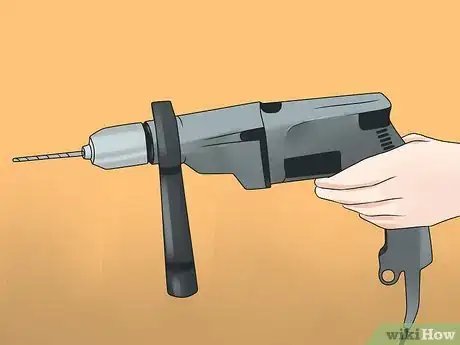

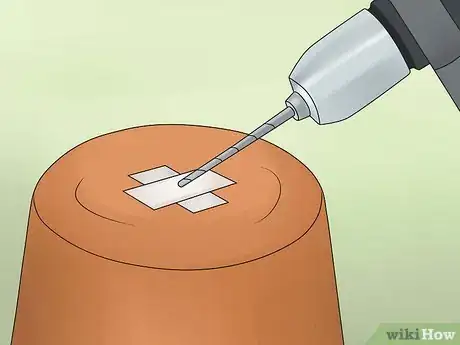
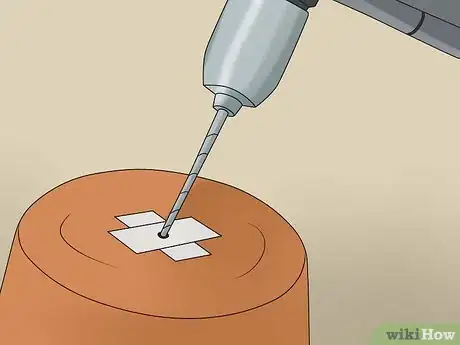
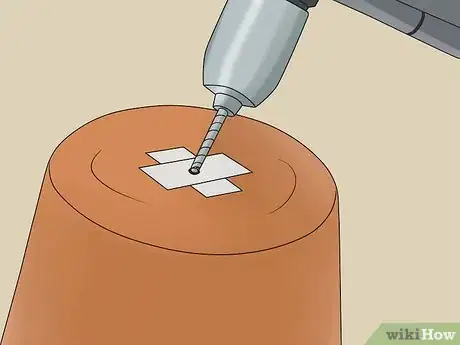
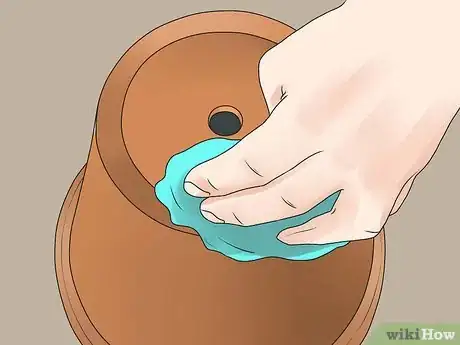
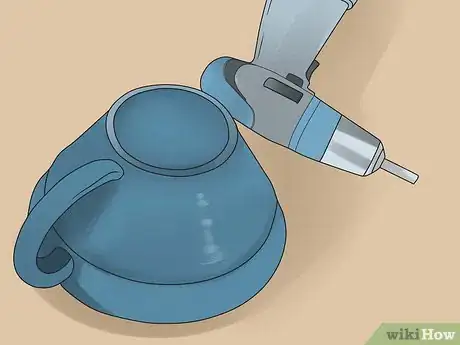
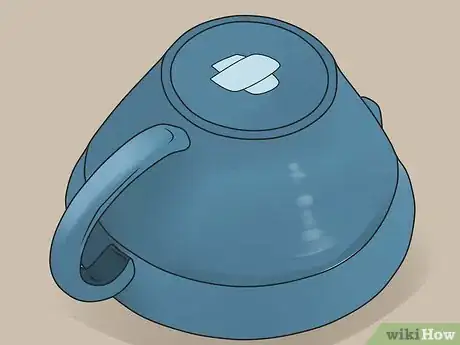
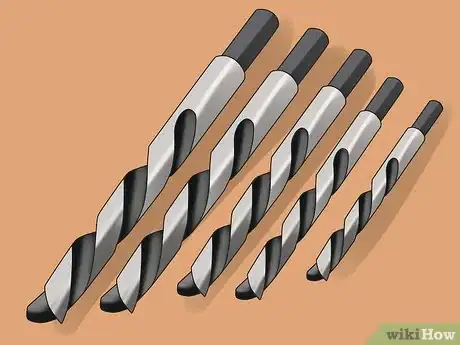
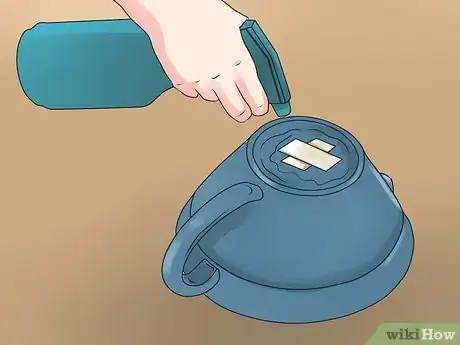

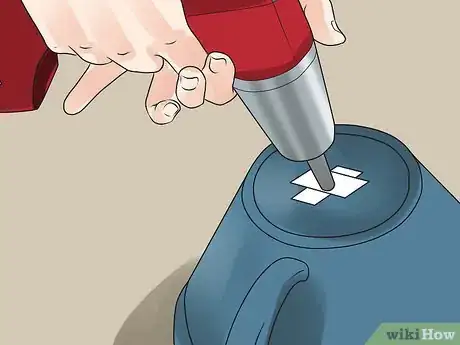
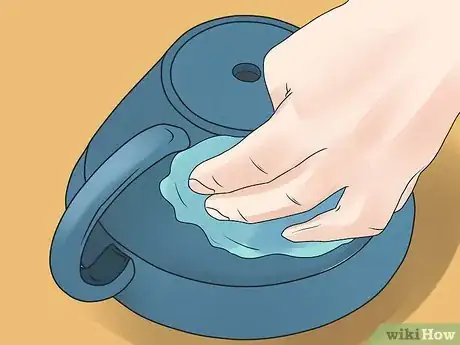





-Oven-Step-15.webp)














































